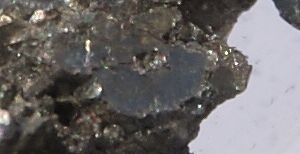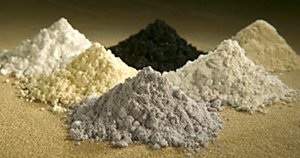The chemical element praseodymium is classed as a lanthanide and rare earth metal. It was discovered in 1885 by Carl Auer von Welsbach.

Data Zone
| Classification: | Praseodymium is a lanthanide and rare earth metal |
| Color: | silvery-white |
| Atomic weight: | 140.9077 |
| State: | solid |
| Melting point: | 931 oC, 1204 K |
| Boiling point: | 3510 oC, 3783 K |
| Electrons: | 59 |
| Protons: | 59 |
| Neutrons in most abundant isotope: | 82 |
| Electron shells: | 2,8,18,21,8,2 |
| Electron configuration: | [Xe] 4f3 6s2 |
| Density @ 20oC: | 6.77 g/cm3 |
Oxidation, Reactions, Compounds, Radii, Conductivities
| Atomic volume: | 20.8 cm3/mol |
| Structure: | close packed (ABCB) |
| Hardness: | – |
| Specific heat capacity | 0.19 J g-1 K-1 |
| Heat of fusion | 6.890 kJ mol-1 |
| Heat of atomization | 356 kJ mol-1 |
| Heat of vaporization | 332.63 kJ mol-1 |
| 1st ionization energy | 523.2 kJ mol-1 |
| 2nd ionization energy | 1018 kJ mol-1 |
| 3rd ionization energy | 2086 kJ mol-1 |
| Electron affinity | 50 kJ mol-1 |
| Minimum oxidation number | 0 |
| Min. common oxidation no. | 0 |
| Maximum oxidation number | 4 |
| Max. common oxidation no. | 3 |
| Electronegativity (Pauling Scale) | 1.13 |
| Polarizability volume | 28.2 Å3 |
| Reaction with air | mild, ⇒ Pr6O11 |
| Reaction with 15 M HNO3 | mild, ⇒ Pr(NO3)3 |
| Reaction with 6 M HCl | mild, ⇒ H2, PrCl3 |
| Reaction with 6 M NaOH | – |
| Oxide(s) | PrO2, Pr2O3 (green), Pr6O11 (black) |
| Hydride(s) | PrH2, PrH3 |
| Chloride(s) | PrCl3 |
| Atomic radius | 185 pm |
| Ionic radius (1+ ion) | – |
| Ionic radius (2+ ion) | – |
| Ionic radius (3+ ion) | 113 pm |
| Ionic radius (1- ion) | – |
| Ionic radius (2- ion) | – |
| Ionic radius (3- ion) | – |
| Thermal conductivity | 12.5 W m-1 K-1 |
| Electrical conductivity | 1.5 x 106 S m-1 |
| Freezing/Melting point: | 931 oC, 1204 K |

Praseodymium metal stored under argon gas. Image Ref.(5)
Discovery of Praseodymium
Praseodymium was first identified in 1885, in Vienna, by Austrian scientist Carl Auer von Welsbach. It was discovered in ‘didymium’ a substance incorrectly said by Carl Mosander to be a new element in 1841. (1)
The nonexistent ‘didymium’ was even given the symbol Di in Mendeleev’s first edition of the periodic table in 1869.
In 1879 French chemist Lecoq de Boisbaudran detected and separated samarium from ‘didymium.’ (1)
After samarium had been discovered, it was noted that ‘didymium’s’ absorption spectrum gave different results depending on which mineral it had been sourced from. (2)
Bohuslav Brauner working in Prague, published a paper on atomic weight determinations in 1882 for rare earth elements and his data for ‘didymium’ were variable. Brauner became convinced that ‘didymium’ was a mixture of elements; he attempted to separate them, but he was not successful. (2)
In 1885 Carl Welsbach, who had discovered ‘didymium’ 14 years earlier, realized it was actually a mixture of two entirely new elements. He named these praseodymium and neodymium. Welsbach reacted ‘didymium’ to form nitrate salts, which he then fractionally crystallized from nitric acid to yield greenish-brown praseodymium and pink neodymium salts.
The fractional crystallization experiments were very time consuming, involving more than one hundred crystallization operations, each lasting up to 48 hours.
Praseodymium was named using the Greek words ‘prasios didymos’ meaning ‘green twin,’ reflecting its green salts and the close association with neodymium.
Pure metallic praseodymium was first produced in 1931. (3)


Praseodymium is used in hybrid car electric motors and generators, iPods, studio lighting and aircraft engines.

Praseodymium colored glass. (photo: Materialscientist)

Clockwise from top center: Rare earth oxides of praseodymium, cerium, lanthanum, neodymium, samarium and gadolinium. Photo: LLNL.
Appearance and Characteristics
Harmful effects:
Praseodymium is considered to be moderately toxic.
Characteristics:
Praseodymium is a soft, malleable, ductile, silvery metal.
Praseodymium is one of the lanthanide rare earth metals.
It forms a flaky black oxide coating (Pr6O11) in air. Unlike many metal oxide layers, this one does not protect the metal from further oxidation. The pale green sesquioxide, Pr2O3, is not stable in air. (4)
Praseodymium reacts with water to form praseodymium hydroxide plus hydrogen gas.
Praseodymium usually exists as a trivalent ion, Pr3+, in its compounds. Most of its salts are pale green in color.
Uses of Praseodymium
Praseodymium is used in high-intensity permanent magnets, which are essential in electric motors and generators used in hybrid cars and wind turbines.
Praseodymium is used in nickel metal hydride (NiMH) rechargeable batteries for hybrid automobiles. The negative electrode (cathode) in NiMH batteries is a mixture of metal hydrides – typically a rare earth misch metal hydride containing praseodymium, neodymium, lanthanum and cerium.
The metal is used as an alloying agent with magnesium creating a high-strength metal for aircraft engines.
Praseodymium is used to make specialized yellow glass goggles for glass blowers and welders.
Flame lighter flints use misch metal (a rare earth alloy) containing praseodymium to produce sparks by friction.
Praseodymium salts are used to color glasses and enamels.
Praseodymium is also used in the core of high-intensity carbon arc lights used by the film industry and in floodlighting.
Abundance and Isotopes
Abundance earth’s crust: 8.7 parts per million by weight, 1.3 parts per million by moles
Abundance solar system: 1 part per billion by weight, 5 parts per trillion by moles
Cost, pure: $470 per 100g
Cost, bulk: $ per 100g
Source: Praseodymium is not found free in nature but is found in a number of minerals mainly monazite and bastnaesite. It is recovered commercially by ion exchange techniques and counter-current liquid-liquid extraction processes from monazite sand and bastnaesite. Praseodymium metal can be prepared by reduction of the anhydrous chloride.
Isotopes: Praseodymium has 32 isotopes whose half-lives are known, with mass numbers 121 to 154. Naturally occurring praseodymium consists of its one stable isotope, 141Pr.

References
- David R. Lide, CRC Handbook of the Chemistry and Physics 86th Edition., Taylor and Francis., 2005, 4-32.
- Ferenc Szabadváry, Handbook of the Chemistry and Physics of the Rare Earths Vol. 11., Elsevier Science Publishers., 1998, p61.
- John Emsley, Nature’s building blocks: an A-Z guide to the elements., Oxford University Press, 2003, p341.
- A lanthanide Lanthology part II., Molycorp, Inc. Mountain Pass, CA, U.S.A.., p30,
- Photo: Jurii
Cite this Page
For online linking, please copy and paste one of the following:
<a href="https://www.chemicool.com/elements/praseodymium.html">Praseodymium</a>
or
<a href="https://www.chemicool.com/elements/praseodymium.html">Praseodymium Element Facts</a>
To cite this page in an academic document, please use the following MLA compliant citation:
"Praseodymium." Chemicool Periodic Table. Chemicool.com. 18 Oct. 2012. Web. <https://www.chemicool.com/elements/praseodymium.html>.
this really helped me with my chemistry assignment
It did with me too!